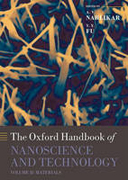
Oxford handbook of nanoscience and technology Vol. 2 Materials: structures, properties and characterization techniques
Narlikar, A.V.
Fu, Y.
This is an agenda-setting and high-profile book that presents an authoritative and cutting-edge analysis of nanoscience and technology. The Oxford Handbookof Nanoscience and Technology provides a comprehensive and accessible overview of the major achievements in different aspects of this field. The Handbook comprises 3 volumes, structured thematically, with 25 chapters each. Volume I presents fundamental issues of basic physics, chemistry, biochemistry, tribology etc. of nanomaterials. Volume II focuses on the progress made with host of nanomaterials including DNA and protein based nanostructures. Volume III highlights engineering and related developments, with a focus on frontal applicationareas. All chapters are written by noted international experts in the field. The book should be useful for final year undergraduates specializing in the field. It should prove indispensable to graduate students, and serious researchers from academic and industrial sectors working in the field of Nanoscience and Technology from different disciplines including Physics, Chemistry, Biochemistry, Biotechnology, Medicine, Materials Science, Metallurgy, Ceramics, Information Technology as well as Electrical, Electronic and Computational Engineering. INDICE: 1. Optical Properties of Carbon Nanotubes and Nano-Graphene; 2. Defects and Disorder in Carbon Nanotubes; 3. Roles of Shape and Space in Electronic Properties of Carbon Nanomaterials; 4. Identification and Separation of Metallic and Semiconducting Carbon Nanotubes; 5. Size Dependent Phase Transitions and Phase Reversal at the Nanoscale; 6. Scanning Transmission Electron Microscopy of Nanostructures; 7. Harmonic Detection of Resonance Methods for Micro-And Nano-Cantilevers: Theory and Selected Applications; 8. Microspectroscopy as a Tool to Discriminate Nano-Molecular Cellular Alterations in Biomedical Research; 9. Holographic Laser Processing for Three-Dimensional Photonic Lattices; 10. Nano-Analysis of Materials Using Near-Field Raman Spectroscopy; 11. Scanning Squid Microscope Study of Vortex States and Phases in Superconducting Mesoscopic Dots, Antidots, and Other Structures; 12. New Phenomena in the Nano-Space of Single Wall Carbon Nanotubes; 13. Thermopower of Lowdimensional Structures: the Effect of Electron-Phonon Coupling; 14. Zno Wide Bandgap Semiconductor Nanostructures: Growth, Characterization and Applications; 15. Selective Self-Assembly of Semimetal Straight and Branched Nanorods on Inert Substrates; 16. Nanostructured Crystals: an Unprecedented Class of Hybrid Semiconductors Exhibiting Structure-Induced Quantum Confinement Effect and Systematically Tunable Properties; 17. Nanoscale GE1-XMNxTE Ferromagnetic Semiconductors; 18. Synthesis, Characterization and Environmental Applications of Nanocrystalline Zeolites; 19. Unusual Properties of Nanoscale Ferroelectrics; 20. Magnetic Properties of Nanoparticles; 21. Structural, Electronic, Magnetic, and Transport Properties of Carbon-Fullerene Based Polymers; 22. Magnetic Nanowires: Fabricationand Characterization; 23. Iron Oxide Nanostructures with Emphasis on Nanowires; 24. DNA-Based Self-Assembly of Nanostructures; 25. Properties and Potentialof Protein-DNA Conjugates for Analytic Applications
- ISBN: 978-0-19-953305-3
- Editorial: Oxford University
- Encuadernacion: Cartoné
- Páginas: 960
- Fecha Publicación: 11/02/2010
- Nº Volúmenes: 1
- Idioma: Inglés
